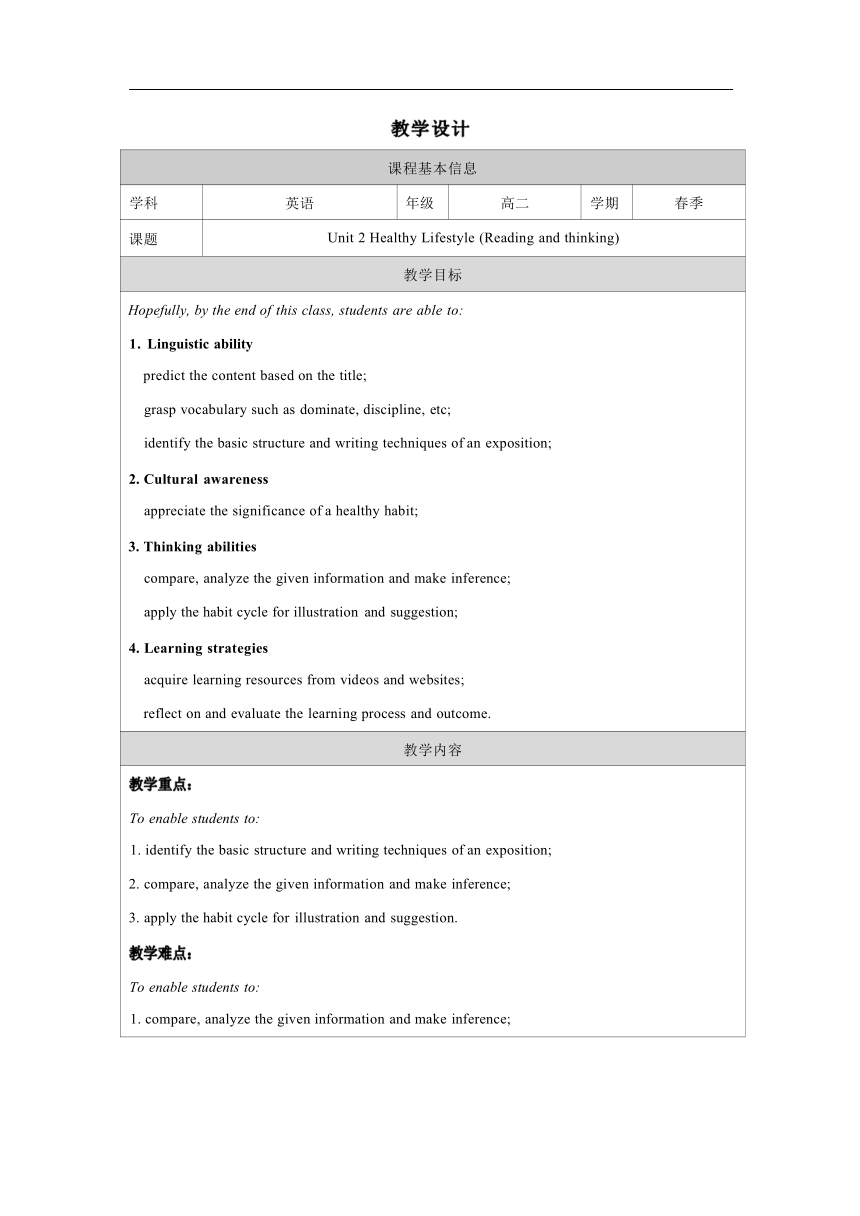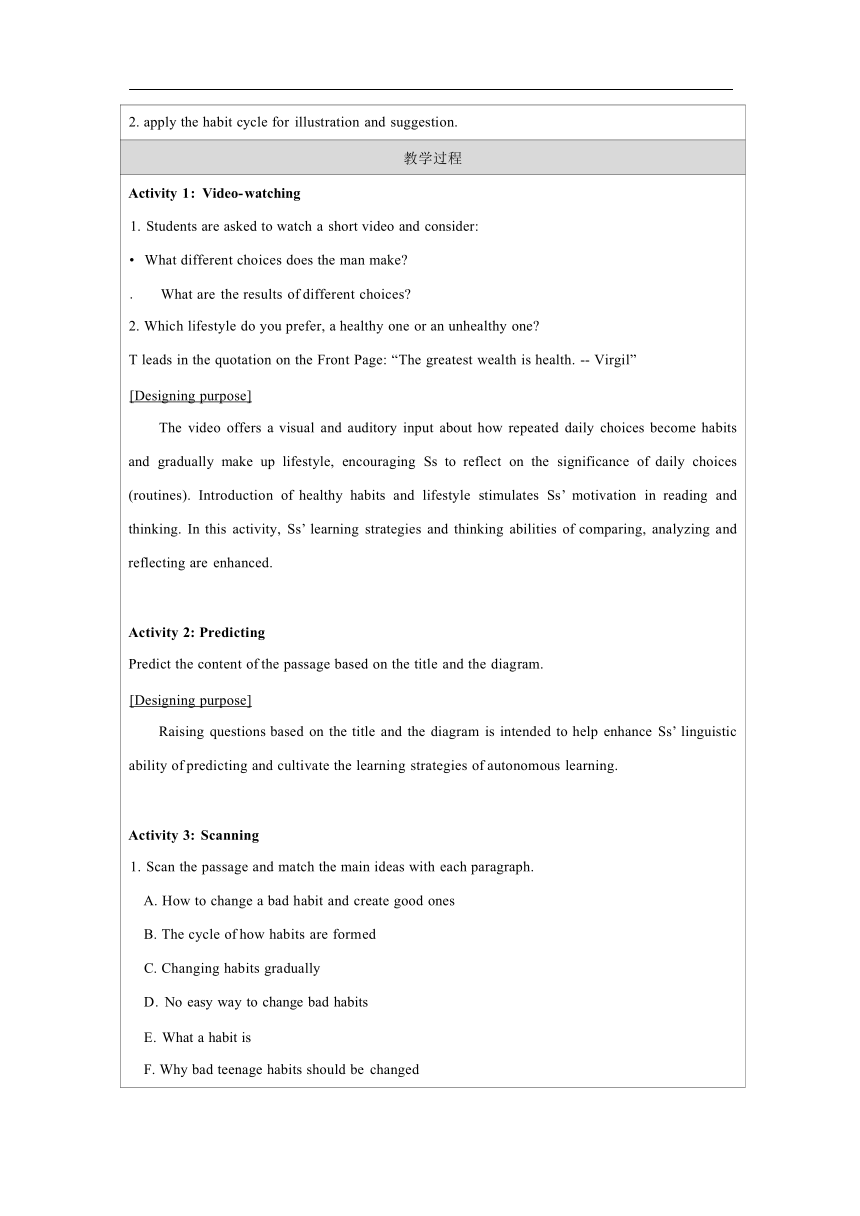人教版(2019)选择性必修第三册 Unit 2 Healthy Lifestyle Opening Page & Reading and Thinking教学设计(表格式)
文档属性
| 名称 | 人教版(2019)选择性必修第三册 Unit 2 Healthy Lifestyle Opening Page & Reading and Thinking教学设计(表格式) |  | |
| 格式 | docx | ||
| 文件大小 | 47.0KB | ||
| 资源类型 | 教案 | ||
| 版本资源 | 人教版(2019) | ||
| 科目 | 英语 | ||
| 更新时间 | 2024-04-06 06:12:39 | ||
图片预览


文档简介
教学设计
课程基本信息
学科 英语 年级 高二 学期 春季
课题 Unit 2 Healthy Lifestyle (Reading and thinking)
教学目标
Hopefully, by the end of this class, students are able to: 1. Linguistic ability predict the content based on the title; grasp vocabulary such as dominate, discipline, etc; identify the basic structure and writing techniques of an exposition; 2. Cultural awareness appreciate the significance of a healthy habit; 3. Thinking abilities compare, analyze the given information and make inference; apply the habit cycle for illustration and suggestion; 4. Learning strategies acquire learning resources from videos and websites; reflect on and evaluate the learning process and outcome.
教学内容
教学重点: To enable students to: 1. identify the basic structure and writing techniques of an exposition; 2. compare, analyze the given information and make inference; 3. apply the habit cycle for illustration and suggestion. 教学难点: To enable students to: 1. compare, analyze the given information and make inference;
2. apply the habit cycle for illustration and suggestion.
教学过程
Activity 1: Video-watching 1. Students are asked to watch a short video and consider: What different choices does the man make . What are the results of different choices 2. Which lifestyle do you prefer, a healthy one or an unhealthy one T leads in the quotation on the Front Page: “The greatest wealth is health. -- Virgil” [Designing purpose] The video offers a visual and auditory input about how repeated daily choices become habits and gradually make up lifestyle, encouraging Ss to reflect on the significance of daily choices (routines). Introduction of healthy habits and lifestyle stimulates Ss’ motivation in reading and thinking. In this activity, Ss’ learning strategies and thinking abilities of comparing, analyzing and reflecting are enhanced. Activity 2: Predicting Predict the content of the passage based on the title and the diagram. [Designing purpose] Raising questions based on the title and the diagram is intended to help enhance Ss’ linguistic ability of predicting and cultivate the learning strategies of autonomous learning. Activity 3: Scanning 1. Scan the passage and match the main ideas with each paragraph. A. How to change a bad habit and create good ones B. The cycle of how habits are formed C. Changing habits gradually D. No easy way to change bad habits E. What a habit is F. Why bad teenage habits should be changed
2. Divide the paragraphs into parts based on the main ideas. [Designing purpose] Scanning for main ideas of each paragraph helps Ss get a clear picture of the basic structure of an exposition with problem-to-solution pattern, navigating Ss’ reading for further information. Ss ’ linguistic ability is highly facilitated in this activity. Activity 4: Detailed reading Read each paragraph intensively and fill in the blanks.
Content Writing techniques
Raise a problem (Para. 1) What is the problem
Analyze the problem (Para. 2-3) 1) What are the reasons behind . make habits hard to change. . Psychological rewards drive us to repeat the same in response to a certain . 2) Can you explain how Peter’s habit of smoking is formed
Offer suggestions (Para. 4-5) What useful advice does the author offer . Replace a physically negative routine with to get rid of bad habits; . Add to the habit cycle to form healthy habits; . and repeatedly take many .
Draw a conclusion 1) What conclusion does the author draw
(Para. 6) 2) What do the words “magic pill” and “delete button” refer to
[Designing purpose] Ss locate, analyze specific information, infer for hidden message and the way information is presented through intensive reading and an in-depth analysis of the habit cycle, which offers Ss a chance to enhance linguistic knowledge and thinking abilities such as analyzing, inferring and illustration. Identifying the writing techniques enables the Ss to grasp the language features of an exposition. Activity 5: Further thinking What advice would you offer Peter to change his habit of smoking [Designing purpose] Ss brainstorm solutions to help Peter, using the habit cycle, during which Ss are encouraged to integrate topic-related knowledge into real-life problem-solving practice. Meanwhile, it also calls for Ss’ innovative thinking to come up with more alternatives. Activity 6: Reflection Reflect on what you have learned this class and finish the checklist.
Checklist
Am I capable of….
Vocabulary □ dominate □ examine □ rely on □ philosophy □ pessimistic □ decide on □ reward □ facilitate □ pill □ negative □ discipline □ delete □ in response to □ tobacco/alcohol abuse
Language skills □ predicting □ scanning □ voicing ideas
Thinking abilities □ analyzing □ comparing □ applying □ making inference
Cultural awareness □ appreciating the significance of healthy habits
Assignment: 1. Reflect on your own unhealthy habits and draw a plan; 2. Search for more ways of forming healthy habits online; 3. Write a letter to your friend Mary, who is struggling with addiction to cellphones, expressing comfort and offering advice. [Designing purpose] It requires Ss’ further extensive reading, offering a stimulus for autonomous reading, mind exchanging and a stage for innovation.
课程基本信息
学科 英语 年级 高二 学期 春季
课题 Unit 2 Healthy Lifestyle (Reading and thinking)
教学目标
Hopefully, by the end of this class, students are able to: 1. Linguistic ability predict the content based on the title; grasp vocabulary such as dominate, discipline, etc; identify the basic structure and writing techniques of an exposition; 2. Cultural awareness appreciate the significance of a healthy habit; 3. Thinking abilities compare, analyze the given information and make inference; apply the habit cycle for illustration and suggestion; 4. Learning strategies acquire learning resources from videos and websites; reflect on and evaluate the learning process and outcome.
教学内容
教学重点: To enable students to: 1. identify the basic structure and writing techniques of an exposition; 2. compare, analyze the given information and make inference; 3. apply the habit cycle for illustration and suggestion. 教学难点: To enable students to: 1. compare, analyze the given information and make inference;
2. apply the habit cycle for illustration and suggestion.
教学过程
Activity 1: Video-watching 1. Students are asked to watch a short video and consider: What different choices does the man make . What are the results of different choices 2. Which lifestyle do you prefer, a healthy one or an unhealthy one T leads in the quotation on the Front Page: “The greatest wealth is health. -- Virgil” [Designing purpose] The video offers a visual and auditory input about how repeated daily choices become habits and gradually make up lifestyle, encouraging Ss to reflect on the significance of daily choices (routines). Introduction of healthy habits and lifestyle stimulates Ss’ motivation in reading and thinking. In this activity, Ss’ learning strategies and thinking abilities of comparing, analyzing and reflecting are enhanced. Activity 2: Predicting Predict the content of the passage based on the title and the diagram. [Designing purpose] Raising questions based on the title and the diagram is intended to help enhance Ss’ linguistic ability of predicting and cultivate the learning strategies of autonomous learning. Activity 3: Scanning 1. Scan the passage and match the main ideas with each paragraph. A. How to change a bad habit and create good ones B. The cycle of how habits are formed C. Changing habits gradually D. No easy way to change bad habits E. What a habit is F. Why bad teenage habits should be changed
2. Divide the paragraphs into parts based on the main ideas. [Designing purpose] Scanning for main ideas of each paragraph helps Ss get a clear picture of the basic structure of an exposition with problem-to-solution pattern, navigating Ss’ reading for further information. Ss ’ linguistic ability is highly facilitated in this activity. Activity 4: Detailed reading Read each paragraph intensively and fill in the blanks.
Content Writing techniques
Raise a problem (Para. 1) What is the problem
Analyze the problem (Para. 2-3) 1) What are the reasons behind . make habits hard to change. . Psychological rewards drive us to repeat the same in response to a certain . 2) Can you explain how Peter’s habit of smoking is formed
Offer suggestions (Para. 4-5) What useful advice does the author offer . Replace a physically negative routine with to get rid of bad habits; . Add to the habit cycle to form healthy habits; . and repeatedly take many .
Draw a conclusion 1) What conclusion does the author draw
(Para. 6) 2) What do the words “magic pill” and “delete button” refer to
[Designing purpose] Ss locate, analyze specific information, infer for hidden message and the way information is presented through intensive reading and an in-depth analysis of the habit cycle, which offers Ss a chance to enhance linguistic knowledge and thinking abilities such as analyzing, inferring and illustration. Identifying the writing techniques enables the Ss to grasp the language features of an exposition. Activity 5: Further thinking What advice would you offer Peter to change his habit of smoking [Designing purpose] Ss brainstorm solutions to help Peter, using the habit cycle, during which Ss are encouraged to integrate topic-related knowledge into real-life problem-solving practice. Meanwhile, it also calls for Ss’ innovative thinking to come up with more alternatives. Activity 6: Reflection Reflect on what you have learned this class and finish the checklist.
Checklist
Am I capable of….
Vocabulary □ dominate □ examine □ rely on □ philosophy □ pessimistic □ decide on □ reward □ facilitate □ pill □ negative □ discipline □ delete □ in response to □ tobacco/alcohol abuse
Language skills □ predicting □ scanning □ voicing ideas
Thinking abilities □ analyzing □ comparing □ applying □ making inference
Cultural awareness □ appreciating the significance of healthy habits
Assignment: 1. Reflect on your own unhealthy habits and draw a plan; 2. Search for more ways of forming healthy habits online; 3. Write a letter to your friend Mary, who is struggling with addiction to cellphones, expressing comfort and offering advice. [Designing purpose] It requires Ss’ further extensive reading, offering a stimulus for autonomous reading, mind exchanging and a stage for innovation.
